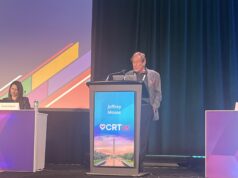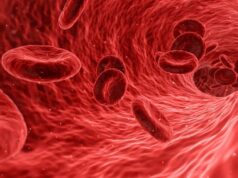
According to a study presented at EuroPCR (16–19 May, Paris, France), compared with optimal medical therapy alone, percutaneous coronary intervention (PCI) significantly improves the health status of patients with chronic total occlusions. This finding differs from that of a previous study—DECISION-CTO—that did not find a difference in quality of life between PCI and optimal medical therapy in patients with chronic total occlusions.
At 12 months, in EURO CTO, PCI was associated with significantly higher Seattle Angina Questionnaire (SAQ) health status scores (the primary endpoint) than was optimal medical therapy.
However, the study did not find a significant difference in the 12-month rate of major adverse cardiac cerebrovascular events (MACCE) between patients who underwent PCI and those who received optimal medical therapy alone. Similarly, DECISION CTO—presented two months prior to EURO CTO at the 2017 scientific session of the American College of Cardiology (ACC; 17–19 March, Washington, DC, USA)—did not find any significant differences in a composite rate of all-cause death, myocardial infarction, stroke, and any repeat revascularisation at three years (the primary endpoint) between PCI and optimal medical therapy. But in contrast to EURO CTO, it also did not find any significant differences in quality of life between the two treatment arms.
In this interview, EURO CTO investigator Gerald S Werner (Medizinische Klinik I (Cardiology & Intensive care), Klinikum Darmstadt GmbH, Darmstadt, Germany), who presented the EuroCTO study at EuroPCR, talks to Cardiovascular News about two studies.
Both DECISION CTO and EURO CTO had difficulties in meeting their pre-specified enrolment targets. Why do you think this was?
To achieve a high procedural success rate with chronic total occlusion PCI, you should only involve expert operators—who are naturally biased towards the positive perception of the procedure and who receive many referred patients. In our study, we did not include referrals.
The locally diagnosed, severe symptomatic patients with large territories of ischemia were often deemed unsuitable for randomisation. It is difficult to convince a patient to not only consider PCI but to also consider being enrolled in a study in which they might end up (after randomisation) only receiving optimal medical therapy. We saw similar problems with recruitment in the COURAGE (optimal medical therapy with or without PCI for stable coronary disease) study.
Furthermore, we also did not include highly symptomatic patients as they were likely to crossover anyway to the PCI arm, and crossover should be limited.
Nevertheless, in EURO CTO, we managed to include about 20% of the screened patients. We did not reach the study number because not all centres had the discipline to screen during the whole study period, and we had some centres with lower overall numbers than others. Of the 26 centers, only 14 were continuously enrolling.
The primary endpoint of DECISION CTO was a composite of all-cause death, myocardial infarction, stroke, and any repeat revascularisation. Do you share the view, as some suggested during ACC, that this was the “wrong endpoint”?
This was a very challenging endpoint for a low number of patients; we are not likely to see prognostic effects in trials below 5,000 patients. But, there was also a major problem in the baseline approach to the patients in the optimal medical therapy group.
Most commentators are not aware that in DECISION CTO patients with multivessel disease were included and randomised occurred before the non-chronic total occlusion lesion was treated. These lesions were treated after the baseline assessment, which means that 70% of PCIs were performed in the optimal medical therapy group; therefore, many symptoms may have been alleviated already by this procedure. Our study included multivessel patients, but the non-chronic total occlusion lesion was treated prior to randomisation; so, randomisation occurred after any non-chronic total occlusion PCI. The baseline assessment should reflect only the impairment due to the chronic total occlusion present.
Why do you think your study showed a difference in quality of life (favouring PCI) but DECISION CTO did not?
The above mentioned basic difference in design is the most likely explanation why we reached our study endpoint and showed a significant improvement in SAQ subscales at 12 months, while DECISION CTO did not see any change. But as mentioned, more than 70% with almost 20% cross-overs for CTOs received PCI in the optimal medical therapy group for the non-chronic total occlusion or chronic total occlusion lesions. The SAQ was done before these procedures, and symptoms were improved by non-chronic total occlusion procedures as well. That is why we see an improvement, in DECISION CTO, in the optimal medical therapy arm that is very strikingly high at one month. This would not happen without PCI. Anyway, that is true for all these trials—including COURAGE—the scores are always higher at baseline than when you look at registries because of the selection bias of physician’s choice and refusal of symptomatic patients to be randomised.
Given that PCI does not appear to lower mortality or revascularisation in a chronic total occlusion population, is improved health status, by itself, a sufficient reason for choosing PCI over medical therapy?
Well, there is compelling evidence that chronic total occlusion PCI does improves mortality—for example, if you look at data from the British Cardiovascular Intervention Society (BCIS) or the Swedish coronary angiography and angioplasty register (SCAAR). These data compare successful PCI to failed PCI, in terms of chronic total occlusions, but the difference in mortality does not relate to early periprocedural events and is evident throughout the follow-up.
To repeat this finding in a randomised trial, we would need 5,000 or more patients with almost no crossover, and this will be almost unethical given what we know already. Nevertheless, PCI is a tool to improve health and not exclusively improve mortality. Quality of life not being impaired by disease is the highest good of man and any measures to improve it are following medical ethics and are in accordance with the statute of the World Health Organization. The clinical benefit was demonstrated in our randomised trial in all aspects both of angina and physical impairment.
Based on the available evidence, when would you choose PCI over medical therapy in a patient with a chronic total occlusion?
We should not forget that extensive antianginal medication, which would be required life-long, impairs the well-being of many patients. Also if you relieve the singular cause of the problem by PCI, then that would be preferred option for most patients. I would rather put the question like this—are there patients for whom we should prefer optimal medical therapy? Certainly, we should limit an often extensive procedure to those patients with impaired health status and a physically active daily life, while elderly patients (elderly according to their biological age) with little impairment in daily life should stay on optimal medical therapy, especially when well tolerated. But definitely, we should not try to convince a patient to undergo a chronic total occlusion PCI on the grounds of prognostic improvement, but only with the promise of improvement of symptoms.
What further data are needed?
The two randomised trials now completed are not really conflicting, when you look at the difference in baseline treatment (pure chronic total occlusion assessment in the EURO CTO trial, mixed treatment of non-chronic total occlusion and chronic total occlusion lesions in DECISION CTO). So the argument that we need another trial to resolve the results of these two trials is not there, because the trials assessed different populations. But nevertheless, it is always reassuring to confirm trial results, and it is well worth to perform a similar confirmatory trial in another part of the world like the USA with a similar health status endpoint.










